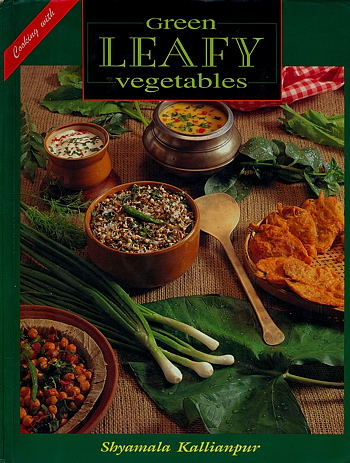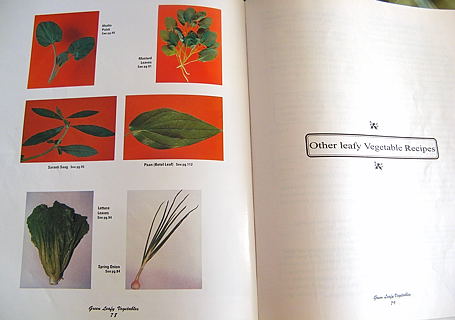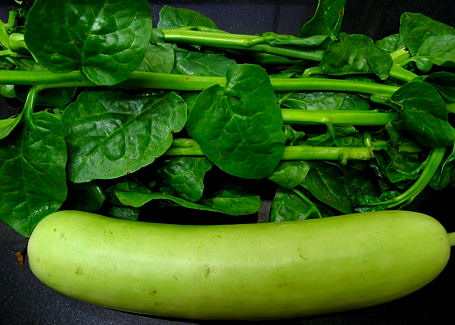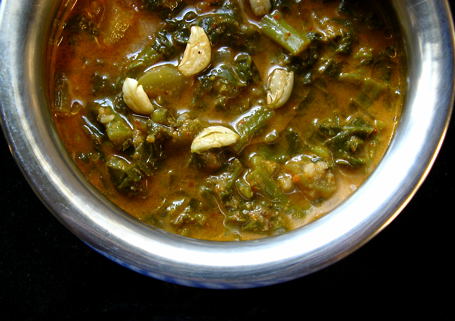Cooking with Green Leafy Vegetables
by Shyamala Kallianpur

If I were Eve in the Garden of Eden, the genesis of my fall from grace might not be the rosy apple, but the seemingly mundane edible greens. Such is the sway that this earthy bounty holds over my taste and imagination. They beckon me at markets with their dewy-fresh looks in variegated shades of green and their promise of glowing health. Thus, each weekend sees the grand entry of a motley bunch into my kitchen. Some of them get used up quickly in a zuNka, aloo-somegreenorother, or a soup. Then my inner child awakens and begins to clamour for something different. This would trigger a search through my cookbooks while the greens waited in anticipation and then shrivelled up with disappointment. For, my cookbooks have plenty of vegetable recipes, but leafy vegetables are almost an afterthought. Even in books that provide a respectable number of greens recipes, the varieties are restricted to spinach and methi, and sometimes mustard leaves. Part of this negligence stems out of certain inherent traits of edible greens; namely, they tend to be stubbornly local and seasonal. Most of them are not amenable to traveling long distances; hence, there are variations in the types of greens found even between neighbouring states. Cookery books intended to reach a pan-Indian or global audience cannot afford to waste space on recipes with main ingredients that are not found everywhere or at all times. It is perhaps a reflection of this constraint that the only cookbook in English on green leafy vegetables in India is self-published by the author.
Cooking with Green Leafy Vegetables by Shyamala Kallianpur should not have gone out of print. It is the only book that provides recipes for over 30 different kinds of edible greens found in India. It has clear colour photographs of about 35 varieties of leafy vegetables. More importantly, greens are treated with the care and respect they deserve. With a couple of exceptions (such as the Sindhi Sai Bhaji), the recipes never involve pressure-cooking the leafy vegetables or overpowering them with spices. They are steamed, sometimes fried, or cooked just until soft or wilted. Thus, the greens retain their flavour, colour, and nutrients in the final dish. The author also demonstrates a meticulousness that is not often seen in Indian cookbooks. For example, she explains the difference between “roughly cutâ€Â, “chopâ€Â, and “finely cut†for leafy vegetables. She not only explains her rationale for giving the measurements for greens in volume, but further tells you how to measure them in the cup (“do not press….but just fill itâ€Â). There are many traditional recipes from different regions of India; however, there are also enough innovative dishes to satisfy the need to do something different once in a while.

The chapters are organized according to specific greens: the commonly available ones such as spinach, methi, amaranth, Malabar spinach (see photo below), and cabbage have separate chapters. Within these chapters, the recipes run the gamut from dry sabzi and gravies to soups, snacks, and salads; especially for the first four of the aforementioned greens. With 64 recipes for these greens, I am now never at a loss when faced with yet another bundle of spinach or methi. The chapter titled Other Leafy Vegetables deals with other easily-available greens such as bathua, green-stemmed and purple-stemmed colocasia leaves, coriander leaves, curry leaves, gongura, kulfa (purslane, paruppu keerai), ambat chuka (khatta palak), mint, mustard leaves, manathakali leaves, spring onion stalks, and saranti saag (ponnanganni). It is the last chapter, however, that I find the most interesting. Rather awkwardly titled, Some More “Other Leafy Vegetables†covers greens that grow in home gardens and are not available in the market, or not used much despite their market availability. Here you will find recipes for beetroot leaves, cauliflower greens, radish leaves, carrot greens, garlic leaves, pumpkin leaves, pomegranate leaves, drumstick leaves, tamarind leaves, brahmi, shepu (dill) taikiLo, omum (celery) leaf, and gherkin (kundru) leaf. There are only a few recipes for each of these vegetables, but the book gives a glimpse of the sheer expanse of possibilities that exists with edible greens.
Before writing this review I tried, rather unsuccessfully, to find the total number of edible leafy vegetables that grow in India. It is no secret that the undocumented heritage of Indian cuisines far exceeds the documented, but I can think of no other area, besides edible greens, where this truism applies more strongly. This study identified 42 species of plants with edible leaves or flowers in a single district in West Bengal. Our awareness is limited to only those greens that make it to the market, either through wholesalers or small village vendors who sell seasonal homegrown fare. Kallianpur’s book should have been just one in a long series of such works by various authors from several Indian states. This might be a tall order for commercial publishers, but an initiative funded by the government or NGOs with a nationwide reach might be one of the ways to highlight this rich culinary biodiversity and preserve it from the forest-fires of globalization.

Top: Malabar spinach, also known as Indian Red Spinach. Bottom: Bottle gourd
Ingredients:
Chopped Indian red spinach – 4 cups
Tender stalks of the spinach, cut into 2-cm length – 2 cups
Bottle gourd – ¼ kg (peeled and diced into small cubes)
Jaggery – 1 tablespoon
Salt to taste
Grind to a fine paste:
Grated coconut – 1 cup
Dried red chillies – 5 (sauté them in a little bit of oil first)
Raw rice – 1 tablespoon (soak it water for 10 minutes)
Tamarind – one lime-sized ball (use less if your tamarind is strong)
Tempering:
Oil – 1 teaspoon
Garlic – 8 to 10 cloves, crushed (no need to peel).
Method:
Take the chopped stalks in a vessel, add one cup of water, cover and cook on low heat till the stalks are tender. Then add the diced bottle gourd and salt. Cover and cook until the bottle gourd is just-cooked, but not too soft. Now add the chopped spinach, jaggery, and ground masala. Bring to a boil and simmer until the spinach is cooked. Remove from heat. Prepare the tempering: heat oil in a small pan or tempering vessel and sauté the garlic, but do not let it brown. Pour the oil and garlic pieces onto the hot cooked vegetables and cover them quickly. Keep for five to ten minutes, then serve hot with rice.

This is a typical dish from Shyamala Kallianpur’s Chitrapur Saraswat community.
Text and Photos: Veena Parrikar
Previously in the Cookery, Indic series:

What an informative and beautifully written artcle! I’m loving this Indic Cookery Series.
Thanks Veena for introducing such great and unknown books.
Comment by Barbara — February 4, 2008 @ 12:13 am
i’m so glad you posted abt this book veena. its a rare find and culinary gem. there r many times i end up cooking same green leafy veg dish whenever i buy them. thank you for introducing this wonderful book. i checked for this book in amazon and so far no luck. hope to get hold of a copy when i visit india next time.
Comment by sia — February 4, 2008 @ 12:50 am
Veena!! Thank you so much for an amazing post. I am not a great fan of greens as I am little fussy but I tend to cook most of the greens for my 6 yr old so guess how much I have enjoyed reading this article!!
Thank you once again
Comment by Padmaja — February 4, 2008 @ 1:47 am
What a wonderful way to introduce this book. Loved reading this!.I am not a big fan of greens..though I started eating it bcos of lil one..but its amazing to know there are so many greens and we can cook them in so many different ways…
This series is so informative. Looking forward for the rest! thanks for the efforts
Comment by Srivalli — February 4, 2008 @ 3:11 am
This bowl of goodness is very inviting. Thanks for the wonderful writeup Veena!
Comment by Nirmala — February 4, 2008 @ 5:25 am
i am amazed at the number of greens avaialable even at our farmers’ markets in season in the u.s. sold by chinese vendors, especially in california. i’m sure most of these are available in india, but are not commonly used.
Comment by bee — February 4, 2008 @ 6:28 am
Thank you for introducing this book.
This green, we call in kannada as “basale soppu”(in Mangalore) and this is exactly how my mother makes it(minus bottle gourd). It brought back wonderful memories!
Comment by Rashmi — February 4, 2008 @ 7:16 am
Hi Veena,
Are there any cabbages that are native to India? I always see english cabbage cooked as patta gobi, and wasn’t sure if there were other vegetables in this family that are native to South Asia. Of course now, we prepare napa cabbage, bok choy, yu choy, in the same way that patta gobi is prepared.
Thanks for your review of this book. I was reading some where that we should eat more leaves. This post gently nudges us in that direction.
Comment by padmaja — February 4, 2008 @ 7:21 am
What a unique combination .. curry looks totally mouthwatering.
Comment by Laavanya — February 4, 2008 @ 8:20 am
Very nice post Veena.
I agree, we have very few cookbooks that are dedicated to green leafy vegetables. Thanks for introducing this book to us.
Comment by Anjali Damerla — February 4, 2008 @ 8:35 am
Thanks for introducing this book. There are only very few green leafy vegetables that I cook. This book is so very informative. Will try to get this one soon.
Comment by Mythreyee — February 4, 2008 @ 9:22 am
Thanks Veena for this great article. Whenever we go tof ind cooking books, they are generally for exotic recipes. Simple and earthy recipes like these are what we need for our everyday cooking.
Comment by vimmi — February 4, 2008 @ 9:24 am
Ah, finally. An answer to my quest of finding familiar greens. Veena and Indira, Thank you for the book reco.
Comment by Suganya — February 4, 2008 @ 9:32 am
Nice article! I recognise almost all of the vegetables mentioned – Mom regularly cooked chukka kura, bacchali, ponnaganti kura, thotakura, gongura, paalakura… I had been looking for Purslane for quite sometime, couldn’t find anywhere. Any idea, what is it called in Telugu?
Thanks
Comment by Madhavi — February 4, 2008 @ 10:52 am
Hi Veena,
Lovely article on greens and never tried spinach with bottlegourd.
thanks for sharing.
Hi Madhavi,
purslane is called pedda paayala aaku or gangapayila aaku in telugu.
If you are in california you can find those greens in any mexican produce like vallarta
Monthly twice i will add purslane in my cooking.
http://vineelascooking.blogspot.com/2006/06/purslane-dal-peddapavila-aaaku-pappu.html
Pizza and coke are great for superbowl, Indira
vineela
Comment by vineela — February 4, 2008 @ 1:04 pm
Thanks Vineela, shall check the store
Comment by Madhavi — February 4, 2008 @ 2:22 pm
Hi Indira,
I tried ur red cabbage,beetroot and red beans curry….it turned out very very good….i didnt have any beets so just tried without it…next time it will be with beets…i have tried many of your recipes and all have them have become a regular part of our meal..thanks for such good recipes….thanks a lot
rashmi
Comment by rashmi — February 4, 2008 @ 2:54 pm
Hi Indira,
It’s been a while since I came over and looks like a lot more recipes. I wondered if you ever tried going to a food co-op. I went to one recently and they have a huge selection of grains.If you have one in seattle you might find it interesting. This is the one that’s my current favorite. http://www.rainbowgrocery.org/index2.html
Keep up the good work 🙂
-Sushma
Comment by Sushma — February 4, 2008 @ 4:56 pm
Indira – I just love your blog and your writing. Inspires me to try out new stuff all the time!
Veena – This article is very informative. Looking forward to more!
Comment by Sangeetha — February 4, 2008 @ 6:38 pm
i would love to get hold of this book so that i can disguise some of the greens and make my husband eat them!! normally its the kids who are picky abt veggies n greens!! :D:D
Comment by Superchef — February 4, 2008 @ 8:36 pm
Hi Indira gaaru,
We prepare bachchali[mayalu in Marathi] pulusu in the same way but without adding gourd.
Thank you for introducing such a great book.
Comment by satya — February 4, 2008 @ 8:42 pm
Amazing post – thank you! Oh, how I do wish I could find this book here in the US…I have a nice (little) book called “Cooking with Asian Leaves” but it’s a baby compared to this one.
I like Malabar Spinach a lot. Here we also call it “Slippery Vegetable” – an evocative and accurate name (if not a very attractive one). But really, I love any greens. I have yet to find a kind I do not like.
Comment by Diane — February 4, 2008 @ 9:47 pm
This is a very informative article, Veena. When people in the West ask me about iron consumption for vegetarians, I just have a big laugh. They have no idea about the wealth of greens available in Asia. And one would never get tired… my mom always made twice a week and there were many varieties. I think before my next trip back home, I’ll have a huge list of regional books to look out for, thanks to this series:)
Comment by Latha — February 5, 2008 @ 6:09 am
I am happy to announce that I own this particular book by Shyamala. My father’s company released an ad in this book and that’s how I came to own it. I have learnt the names of various greens by looking at the snaps provided in this book. Good article!
Comment by Lavs — February 5, 2008 @ 6:18 am
thanks a lot for sharing this article Indira.
I think i will purchase a copy of this book now, i if get it somewhere.
I love leafy veggies and beans a lot.
Comment by Pooja — February 5, 2008 @ 1:29 pm
Oh that was a very nice post. Love leafy veggies.
Comment by babin — February 6, 2008 @ 10:20 am
Hi Veena and Indira!
I tried this recipe today. I followed the exact recipe except replacing jaggery with a tsp sugar (as I did not have jaggery) and omitting garlic (As we do not prefer smell of garlic in some foods). And it came out very delicious. we liked it very much. Just wanted to let you know. Thanks for sharing nice recipe with us.
Madhavi
Comment by Madhavi — February 6, 2008 @ 11:17 am
I love both of these ingredients, but have never tried them together. Sounds absolutely wonderful, though! Thanks so much for the additional education. I learn so much when I come here. 🙂
Comment by Kalai — February 6, 2008 @ 3:56 pm
I want that book, now! And the other one about salads and the other one about the recipes from the aunt of the young ladies. I cannot resist cookery books and now I cannot get my hands on the so beautifully reviewed books. Despite what negative comments you get on your blogs, Indira, what you do is remarkable and do not let the negativity deter you or take away your enthusiasm.
And Veena Parrikar, kudos to you for the beautiful reviews and bringing us hitherto unknown gems of authors.
Comment by ash — February 6, 2008 @ 5:01 pm
This sounds like a great recipe book. I’m a green fanatic and come winter, fill my shopping bag with assorted greens that all too oftehn wilt before I can think of something to do with them. I must try and dig this gem out.
Comment by bird's eye view — February 8, 2008 @ 3:35 am
Thanks for letting us all know about this book. 🙂
Comment by Mona — February 8, 2008 @ 1:20 pm
Thanks for the intro of this book. I have never tried this combination before. Tried it last week. It was good.
Thanks again.
Sarada
Comment by Sarada — February 14, 2008 @ 1:09 pm
with so many leafy veggies,it helps to identify them with pictures of each although i haven’t had much luck finding info on seashore methi, it looks like clover sprouts but have that unique methi flavour…is there particular name for it ?
Comment by melody — February 22, 2008 @ 6:45 am
Tried the recipe. Tasted delicious but did not look that good ;)(maybe the way I made it).
Comment by Nidhi — May 16, 2008 @ 8:16 am
This is the ony book which has detailed recipe’s for green vegtables. It also mentions the nutritional values for each recipe. It has received recognition from the health institue for being 1 step ahead of them. Not only are the recipe’s tasty but it is also very healthy. I am glad to have a copy.
Comment by Supriya. Kallianpur — May 17, 2008 @ 9:41 am
Hopefully, new copies are printed and you guys can have the copies too. Its a must have.
Comment by Supriya. Kallianpur — May 17, 2008 @ 9:49 am
The book finally reached me today Indira!! thanks to u and veena , Its lovely and filled with many amazing recipes !!
Wow! Congratulations Dee. I look forward to reading about the book and recipes at your blog.
-Indira
Comment by Dee — May 27, 2008 @ 5:38 pm
I am very much interested in obtaining a copy of Green Leafy Vegetables by Shyamala Kallianpur and Manipal Mahila Samaj:Regional Rustic Recipes.
I have tried calling India direct but was not able to get through.
Do you have any suggestions?
I would appreciate any help you can offer.
Hello Alonia,
Secondhand book shops in India are the best bet to locate these two out of print books. Or you could write to Veda Books.com, an online Indian bookstore. They have a wide variety of cookbooks both in English and local languages. Hope this helps.
-Indira
Comment by Alonia Rose — June 23, 2008 @ 7:10 pm
Hi Indira/Veena,
Can you guide me on how to get the books:
Cooking with Green Leafy Vegetables
by Shyamala Kallianpur
Pickle digest : usha Prabhakaran
Thanks for the help,
Shubha
Comment by Shubha — February 28, 2009 @ 5:05 pm
Thanks Indira,
Prepared it today and came out delicious.
My 6 yr. old daughter also enjoyed very much.
Comment by Kavita — June 23, 2010 @ 1:56 am
hi
where can i get a book of “Cooking with Green Leafy Vegetables”
by Shyamala Kallianpur
Comment by naveen — July 19, 2012 @ 3:29 am
Hi iam from India…where ca I get hold of tis amazing book
Comment by Shivani — July 31, 2012 @ 7:04 am